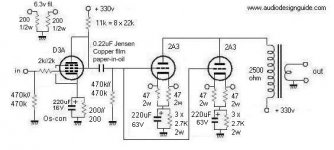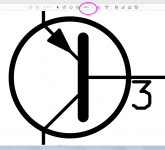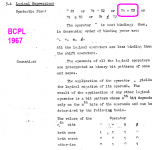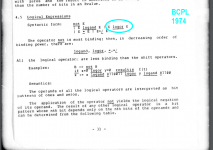A thing I truly hate, when one uses obscure, antique or just plain "made up" symbols in schematics. Stop people, don't just pull this outta your behind.
This one I'm likely going to build, but before I head off stateside (One month)...I have to decipher the non-standard symbols...for the handful of parts.
Now, we have three variations
like 11K=8X22K 470K//470K
3X2.7K
I'm guessing the 11K is the final value AFTER arranging eight 22Ks
the 470K//470K LOOKS like a pair of 470 in parallel for 235K ohms
The "three times 2700 ohm" third variation, I have no idea.
-----------------------------------------------------------------------------Rick....
This one I'm likely going to build, but before I head off stateside (One month)...I have to decipher the non-standard symbols...for the handful of parts.
Now, we have three variations
like 11K=8X22K 470K//470K
3X2.7K
I'm guessing the 11K is the final value AFTER arranging eight 22Ks
the 470K//470K LOOKS like a pair of 470 in parallel for 235K ohms
The "three times 2700 ohm" third variation, I have no idea.
-----------------------------------------------------------------------------Rick....
Attachments
Last edited:
A thing I truly hate, when one uses obscure, antique or just plain "made up" symbols in schematics. Stop people, don't just pull this outta your behind.
You must be kidding.I'm guessing the 11K is the final value AFTER arranging eight 22Ks
the 470K//470K LOOKS like a pair of 470 in parallel for 235K ohms
The "three times 2700 ohm" third variation, I have no idea.
Obviously they are making it clear, very clear, that they want resistors made out of an array of regular ones, instead of a single one.
I can even find logic in that.
Clearly parallel or series parallel arrays.
FWIW I *often* find 0.1 ohm (wirewound 5W ceramic type) resistors used in mixed feedback Guitar amps replaced by 10x1 ohm carbon film ones in parallel.
Madness if hand assembled but reasonble if done by a pick and place machine.
Last edited:
NO, it is NOT plain as day...
the two values written either side of two "Slashes"...slashes are not in any electronics book of mine?
Using a narrative for a value directly on a schematic is wholly unacceptable.
"Three times 2.7K" is literally 8100 ohms..."times" is very very different from a three legged parallel circuit.
If indeed one wants to divide out current and voltage with resistance, simple, put a footnote on it...ya know?, those little numbers that should tell you, "read me first!"
There is where you write out the narrative.
-----------------------------------------------------------------------Rick.....
the two values written either side of two "Slashes"...slashes are not in any electronics book of mine?
Using a narrative for a value directly on a schematic is wholly unacceptable.
"Three times 2.7K" is literally 8100 ohms..."times" is very very different from a three legged parallel circuit.
If indeed one wants to divide out current and voltage with resistance, simple, put a footnote on it...ya know?, those little numbers that should tell you, "read me first!"
There is where you write out the narrative.
-----------------------------------------------------------------------Rick.....
// means "in parallel" and it´s THE proper sign to indicate that in Math, more specifically in Geometry:

also:
so its use in Electronics is common and understood.
2k2//2k2 means two 2k2 resistors in parallel, what else?
Not much "narrative" involved, but cold hard boring Math.
EDIT:
symbols - How to draw the "parallel circuits" sign "//"? - TeX - LaTeX Stack Exchange
also:
An externally hosted image should be here but it was not working when we last tested it.
so its use in Electronics is common and understood.
2k2//2k2 means two 2k2 resistors in parallel, what else?
Not much "narrative" involved, but cold hard boring Math.
EDIT:
symbols - How to draw the "parallel circuits" sign "//"? - TeX - LaTeX Stack Exchange
I remember seeing the notation "R1 // R2" in electronics books, meaning "(R1^-1 + R2^-1 )^-1", i.e. the resistance of R1 and R2 connected in parallel. What is the correct way of typesetting the "//" sign?
Last edited:
Using a narrative for a value directly on a schematic is wholly unacceptable.
-----------------------------------------------------------------------Rick.....
You should immediately report Andrea Ciuffoli to the Italian Carabinieri for reckless audio design, ignoring Ohm's Law and causing grievous mental anguish.
New 2A3
Last edited by a moderator:
I use those symbols but I would not recommend putting the value inside, it can make it difficult to read. I know however that some people do. 
Most reviewer/approvers, etc really appreciate legible and easily read schematics - I know I do and unfortunately I review a lot of them. Now mistake free would be nice too, but that never happens... LOL
Most reviewer/approvers, etc really appreciate legible and easily read schematics - I know I do and unfortunately I review a lot of them. Now mistake free would be nice too, but that never happens... LOL
Not a "sin" per se but often there is not enough space inside the box to use a readable font or letter edges touch box lines.Ok, so how big of a sin is it to put the resistor value inside the box (when using euro-style resistor symbols)?
Maybe just readable on the original but when you photocopy or .jpeg it, easy to become very unreadable.
No sure why so many people use .jpg for schematics (which are B/W or limited colour palette, 16 is already way too many) while .jpg was invented to improve colour and reduce pixellation in family/holiday pictures.
Improves perceived colour but DESTROYS definition because it interpolates pixels with those around it, there are NO sharp edges so small text and details become unreadable by design.
Oh well.
I always post my own schematics as .gif or .png which are compact and lossless but not many do.
Scalable vector graphics, found in .pdf documents and produced by several schematics editors (notably KiCad), have infinite resolution. Put em on an 8192 x 8192 display and there's no pixellation.
Here's an example. View the .pdf (attachment #2) at the highest magnification your "Adobe Acrobat DC Reader" software will allow; mine goes up to 3200%. There's no pixellation.
_
Here's an example. View the .pdf (attachment #2) at the highest magnification your "Adobe Acrobat DC Reader" software will allow; mine goes up to 3200%. There's no pixellation.
_
Attachments
Last edited:
To summarize
… 470 kΩ || 470 kΩ is 235 kΩ
… 3 × 2.7 kΩ is definitely 900 Ω, since 8.1 kΩ would be too big
… 2 kΩ || 2 kΩ → 1 kΩ
… 8 × 22 kΩ definitely is 2 sets of 4 in parallel, the sets in series.
… and || or // means 'parallel'. Since about 1965.
At least in North America, the | symbol is directly on the keyboard of any computer since the 'CRT' or cathode-ray terminal. Indeed, the 'C' language was the first mainstream language to capitalize on the '|' symbol to mean or. '/' is division. the '//' symbol might conceivably mean double division, which for parallel resistors is really close to the truth … 1 / (1/R1 ⊕ 1/R2 ⊕ 1/R3 ⊕ 1/R...) is the parallel value. Double division! (in some successors to 'C', '//' starts in-line comments. )
And I agree with whomever said, “the symbols are standard”, but only the values are creatively non-standard. creatively means that “if you are a competent designer or repairman, the hints along with Ohm's law will ensure you got the idea and can keep moving on.”
⋅-⋅-⋅ Just saying, ⋅-⋅-⋅
⋅-=≡ GoatGuy ✓ ≡=-⋅
… 470 kΩ || 470 kΩ is 235 kΩ
… 3 × 2.7 kΩ is definitely 900 Ω, since 8.1 kΩ would be too big
… 2 kΩ || 2 kΩ → 1 kΩ
… 8 × 22 kΩ definitely is 2 sets of 4 in parallel, the sets in series.
… and || or // means 'parallel'. Since about 1965.
At least in North America, the | symbol is directly on the keyboard of any computer since the 'CRT' or cathode-ray terminal. Indeed, the 'C' language was the first mainstream language to capitalize on the '|' symbol to mean or. '/' is division. the '//' symbol might conceivably mean double division, which for parallel resistors is really close to the truth … 1 / (1/R1 ⊕ 1/R2 ⊕ 1/R3 ⊕ 1/R...) is the parallel value. Double division! (in some successors to 'C', '//' starts in-line comments. )
And I agree with whomever said, “the symbols are standard”, but only the values are creatively non-standard. creatively means that “if you are a competent designer or repairman, the hints along with Ohm's law will ensure you got the idea and can keep moving on.”
⋅-⋅-⋅ Just saying, ⋅-⋅-⋅
⋅-=≡ GoatGuy ✓ ≡=-⋅
Last edited:
Indeed, the 'C' language was the first mainstream language to capitalize on the '|' symbol to mean or.
The PL/I programming language used the vertical bar character '|' to mean logical-OR, too. It was released by IBM, to its enormous base of System/360 customers, in 1967 [according to Wikipedia].
The C programming language was created in 1972, according to Wikipedia. It was descended from the B programming language, which was created in 1969.
C (1972) got it from B (1969), B got it from BCPL (1967) I believe. Whether BCPL was influenced by PL/I I don't know.the 'C' language was the first mainstream language to capitalize on the '|' symbol to mean or.
Pascal (1970) has | for bitwise or too.
At that time none of BCPL / B / C were mainstream of course. Pascal was, so it's probably the first mainstream
language to use |
Last edited:
The Internet Archive ("wayback machine") has a copy of the BCPL User's Manual from 1967: LINK-1
It says the operator for logical AND is conjunction character up-hat, roughly /\ . . . . and it also says the logical operator for logical OR is the disjunction character down-hat, roughly \/ .
However, neither of these symbols has an ASCII character code or an EBCDIC character code. Neither of them appear on an IBM model 029 card punch, which was the preferred method of writing computer program source code in 1967.
So they decided that implementations of BCPL would use the symbols logand , logor for logical AND , logical OR , respectively. These symbols certainly can be represented in ASCII and EBCDIC , and these can be typed on a card punch. See section 2.1.1 page 2.
Later revisions of the BCPL user manual explicitly include the logand , logor symbols and omit the up-hat , down-hat characters entirely. A fine example is the 1974 edition of the manual archived at the Office Of Naval Research, ARPA: LINK-2
I have attached screen capture images of the relevant sections below.
_
It says the operator for logical AND is conjunction character up-hat, roughly /\ . . . . and it also says the logical operator for logical OR is the disjunction character down-hat, roughly \/ .
However, neither of these symbols has an ASCII character code or an EBCDIC character code. Neither of them appear on an IBM model 029 card punch, which was the preferred method of writing computer program source code in 1967.
So they decided that implementations of BCPL would use the symbols logand , logor for logical AND , logical OR , respectively. These symbols certainly can be represented in ASCII and EBCDIC , and these can be typed on a card punch. See section 2.1.1 page 2.
Later revisions of the BCPL user manual explicitly include the logand , logor symbols and omit the up-hat , down-hat characters entirely. A fine example is the 1974 edition of the manual archived at the Office Of Naval Research, ARPA: LINK-2
I have attached screen capture images of the relevant sections below.
_
Attachments
Thank you for that. I was only lucky enough (and in a way lazy enough) to learn basic first in the early 1970s on a machine that a person could actually buy retail: CompuColor I. It was wonderful … 4 K of memory, built-in BASIC in ROM, and yep… a real live 55 kB one-sided 5¼ inch floppy disk drive. And a COLOR screen! For $2,250 out the door, shipped.
After exhausting that with hundreds of self-written programs, and learning the really fine art of subroutines-and-return-value-conventions, I ran into quite a few older (and frankly much smarter) people at the University who told me of a most amazing thing, "Small-C" and its variant "Tiny C", which one could get on a floppy disk of the more standard 8", 128 kB variety. Which then caused me to buy Cromemco build-your-own S–100 card-and-backplane kit stuff … to make a CP/M machine, that could compile C. Tiny C. Which or another $35, included the 3 disks of source code, allowing it to compile itself.
What a mind wringing concept!
A compiler that'd compile its source code and produce ALL the executables that were originally included on Disk 1. Leading to the obvious… but… but… how did the first ever get compiled? Which was a rabbit-hole of cross-compilers, B language, BCPL language and the University Henchmen of Languages … LEX and YACC. Lexical-Expression (parser) to turn ASCII into a C language token parser, which feeds YACC, the 'yet-another-compiler-compiler', along with the token-to-metacode rules, which then feeds a metacode-to-assembler, which pushes out machine language, in the 'right format' for the particular operating system (CP/M) to recognize as a valid executable, and cede execution rights to.
Thus your bug-ridden code runs.
The REAL trip tho' wasn't quite that, but like the bumble-bee not knowing that Physics decreeing it was an un-flight-worthy bug, my new business partner and I decided to write (in C) a full-on cross-compiler for a long-deceased language called C-Basic. Which for awhile had a wide-but-spotty influence over the small business accounting-and-applications writing community.
What better than to take it from CP/M to MSDOS, right?
I hadn't yet taken the Computer Languages classes at the Big U, so had to write it all from scratch. Every … last … line. What a complete gas!
Lex'ing wasn't too hard. Numbers are a bummer, especially all the inconvenient rules of floating point. And there was this decidedly C-ish 'problem' with some non-BASIC operators, the ++ (either postfix or prefix) and all that. Token look-ahead. And unpopping. And all the idiotic-programmer-did-the-wrong-thing parsing. End of File characters where they don't belong. Overly long expressions that kill the stack. All that.
Thing is, though, it worked! Had a client (programming firm), with zillions of .BAS files, and it compiled them all. Without hitch! After about 5 days of trying, LOL. Trying, fixing the buggy compiler source code, re 'making' another one, trying again. 15 hour days. Yay!
The really hard part though was finishing off the parts of the language that weren't strictly required for business programming, but an integral part o the BASIC and C-BASIC spec. sin(), cos(), tan(), asin()… log(), ln(), √(), … just about every part of the math-and-trig part of the BASIC standard.
Then we found out that 'floating point' was a real deal … and the code generator I wrote was completely ignorant of the binary-format that BASIC wanted to support for native binary filesystem data. Oh, lord. And the format wanted by the 8087 co-processor. And what to do to floating point numbers withOUT the 8087. And… a rabbit hole. 3 months. The hardest part (thank the gods I had a UC graduated mathematics major as a partner!) was "re-discovering" the rather convoluted formulæ to do the transcedental (sin, cos, tan, log, exp) math to 12 significant figures, in an amount of time measured in microseconds.
While not a single .BAS file from the hundreds required it, I was a purist, a perfectionist. We got it working though. All of it.
… then there were the issues of writing the 'terminal interfaces', for the ANSI driver on MSDOS. That was another big bag of tricks. Especially to get to run really fast. Had to write an ANSI.SYS driver from scratch. But 'C' was good at that.
Ultimately, in about 18 months, we got the whole project written. It would compile anything, we wrote a portable MAKE (project compiler-linker in the style of UNIX) and packaged it up in several diskettes. Writing the user manual turned out to be another tedious rabbit hole, because we didn't have access to an affordable TeX or similar photo-typesetter. What a cluster-f. Lots of money, proofreading, lots of battles with lame printing shops, we got manuals. Couple of thousand bucks later.
And sold the thing for $199 a copy, free shipping. A few hundred, maybe just over 1,000 ultimately went out. NO WAY it paid for the 18 months. Not even close. And the support head-aches… all this before support contracts and yearly subscription models of revenue. Before functioning Internet-to-Business links. Telephones, answering machines, Faxes and US postage stamps.
Would I do it again? YES!
But with YACC, LEX and some of the better tools that UC Berkeley's Computer Science department taught me to use.
... Sling-shots are so much better than spears.
... ... And bows-and-arrows best sling shots.
... ... ... Crossbows are even better.
... ... ... ... A horse is useful.
... ... ... ... ... Run away!!!
Comically, ⋅-=≡ GoatGuy ✓ ≡=-⋅
After exhausting that with hundreds of self-written programs, and learning the really fine art of subroutines-and-return-value-conventions, I ran into quite a few older (and frankly much smarter) people at the University who told me of a most amazing thing, "Small-C" and its variant "Tiny C", which one could get on a floppy disk of the more standard 8", 128 kB variety. Which then caused me to buy Cromemco build-your-own S–100 card-and-backplane kit stuff … to make a CP/M machine, that could compile C. Tiny C. Which or another $35, included the 3 disks of source code, allowing it to compile itself.
What a mind wringing concept!
A compiler that'd compile its source code and produce ALL the executables that were originally included on Disk 1. Leading to the obvious… but… but… how did the first ever get compiled? Which was a rabbit-hole of cross-compilers, B language, BCPL language and the University Henchmen of Languages … LEX and YACC. Lexical-Expression (parser) to turn ASCII into a C language token parser, which feeds YACC, the 'yet-another-compiler-compiler', along with the token-to-metacode rules, which then feeds a metacode-to-assembler, which pushes out machine language, in the 'right format' for the particular operating system (CP/M) to recognize as a valid executable, and cede execution rights to.
Thus your bug-ridden code runs.
The REAL trip tho' wasn't quite that, but like the bumble-bee not knowing that Physics decreeing it was an un-flight-worthy bug, my new business partner and I decided to write (in C) a full-on cross-compiler for a long-deceased language called C-Basic. Which for awhile had a wide-but-spotty influence over the small business accounting-and-applications writing community.
What better than to take it from CP/M to MSDOS, right?
I hadn't yet taken the Computer Languages classes at the Big U, so had to write it all from scratch. Every … last … line. What a complete gas!
Lex'ing wasn't too hard. Numbers are a bummer, especially all the inconvenient rules of floating point. And there was this decidedly C-ish 'problem' with some non-BASIC operators, the ++ (either postfix or prefix) and all that. Token look-ahead. And unpopping. And all the idiotic-programmer-did-the-wrong-thing parsing. End of File characters where they don't belong. Overly long expressions that kill the stack. All that.
Thing is, though, it worked! Had a client (programming firm), with zillions of .BAS files, and it compiled them all. Without hitch! After about 5 days of trying, LOL. Trying, fixing the buggy compiler source code, re 'making' another one, trying again. 15 hour days. Yay!
The really hard part though was finishing off the parts of the language that weren't strictly required for business programming, but an integral part o the BASIC and C-BASIC spec. sin(), cos(), tan(), asin()… log(), ln(), √(), … just about every part of the math-and-trig part of the BASIC standard.
Then we found out that 'floating point' was a real deal … and the code generator I wrote was completely ignorant of the binary-format that BASIC wanted to support for native binary filesystem data. Oh, lord. And the format wanted by the 8087 co-processor. And what to do to floating point numbers withOUT the 8087. And… a rabbit hole. 3 months. The hardest part (thank the gods I had a UC graduated mathematics major as a partner!) was "re-discovering" the rather convoluted formulæ to do the transcedental (sin, cos, tan, log, exp) math to 12 significant figures, in an amount of time measured in microseconds.
While not a single .BAS file from the hundreds required it, I was a purist, a perfectionist. We got it working though. All of it.
… then there were the issues of writing the 'terminal interfaces', for the ANSI driver on MSDOS. That was another big bag of tricks. Especially to get to run really fast. Had to write an ANSI.SYS driver from scratch. But 'C' was good at that.
Ultimately, in about 18 months, we got the whole project written. It would compile anything, we wrote a portable MAKE (project compiler-linker in the style of UNIX) and packaged it up in several diskettes. Writing the user manual turned out to be another tedious rabbit hole, because we didn't have access to an affordable TeX or similar photo-typesetter. What a cluster-f. Lots of money, proofreading, lots of battles with lame printing shops, we got manuals. Couple of thousand bucks later.
And sold the thing for $199 a copy, free shipping. A few hundred, maybe just over 1,000 ultimately went out. NO WAY it paid for the 18 months. Not even close. And the support head-aches… all this before support contracts and yearly subscription models of revenue. Before functioning Internet-to-Business links. Telephones, answering machines, Faxes and US postage stamps.
Would I do it again? YES!
But with YACC, LEX and some of the better tools that UC Berkeley's Computer Science department taught me to use.
... Sling-shots are so much better than spears.
... ... And bows-and-arrows best sling shots.
... ... ... Crossbows are even better.
... ... ... ... A horse is useful.
... ... ... ... ... Run away!!!
Comically, ⋅-=≡ GoatGuy ✓ ≡=-⋅
Last edited:
- Home
- Design & Build
- Parts
- Non standard Schematic symbols



